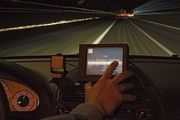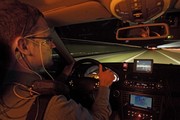Merc develops fatigue detection
System knows if you're asleep at the wheel
Mercedes Benz has thrown some light into its thinking and processes as it develops a system that will detect when you're in danger of falling asleep at the wheel.
Over the course of their investigations, the company's team of engineers, cyberneticists, mathematicians, computer scientists and psychologists is testing out a variety of methods for detecting driver fatigue as soon as it sets in. One of these techniques is the eye-blink observation method: an infrared camera directed at the driver's head permanently monitors the eye-blink frequency, enabling microsleep to be detected the instant the eyes stay closed for a certain period of time. A warning signal sounds in the car's cockpit in response.
In order to obtain objective indicators of fatigue, other physiological readings such as the electroencephalogram (EEG) are used. Yet another method is based on the analysis of dynamic driving data, such as steering or braking characteristics. One of the systems triggers an alarm if the driver does not move the steering wheel for a prolonged period of time.
Detecting fatigue
However, initial results obtained by the engineers in Sindelfingen indicate that the observation of individual criteria alone does not allow reliable detection of tiredness. Fatigue is a highly complex phenomenon that can manifest itself in all manner of ways. In view of this, Mercedes-Benz will make use of a whole host of factors for fatigue detection, including the individual driving style, the duration of the journey, the time of day and the current traffic situation. By continually comparing this data with stored empirical values, the system will be able to compile an individual driver profile and use probability calculus to determine whether the driver is exhibiting the first signs of fatigue.
The principal goal of the development project is to detect the gradual transition from the state of being fully awake to being tired, in other words from high powers of concentration to a clear attention lapse, and warn the driver before he or she becomes over-fatigued and thereby jeopardises safety.
What is fatigue?
Fatigue is a natural reaction of the body but, nevertheless, a hazardous one as many motorists are oblivious to its onset. They are exhausted and need to sleep but they continue driving - running a tremendous risk in the process.
The phenomenon that threatens to occur in this type of situation is referred to by experts as "microsleep": a spontaneous reaction of the human organism to over-fatigue. The eyes sting, the lids blink more frequently but more slowly too, the pupils become smaller, the driver yawns and shivers - all telltale warning signs of this phenomenon. Should the eyes remain closed for just one second longer than usual the consequences can be fatal, as in this second the car covers a whole 28 metres when travelling at a speed of 62mph -- effectively driverless and therefore out of control.
Microsleep with the eyes still open, which is also regularly observed by scientists during their investigations, is no less perilous. In this state, the brain processes what the eyes see very slowly or not at all, greatly lengthening the reaction times.
Darkness, monotony and overstrain are the most frequent triggers of microsleep at the wheel. A survey of drivers in Canada revealed that 27 per cent regularly drove between four and six hours on long journeys without a break. Investigations have shown, however, that drivers can react up to 50 per cent more slowly after just four hours of non-stop driving. The accident risk doubles after driving for this length of time and increases by more than eight fold after six hours behind the wheel.
Not only do tired motorists react more slowly and misjudge hazardous situations, they also overestimate their own capabilities and feel more alert than they actually are - characteristic symptoms of fatigue which are similar to those observed after excessive consumption of alcohol.
Chronic sleep disorders
A dangerous onset of fatigue whilst driving can also be provoked by a lack of sleep. Studies indicate that at least 20 per cent of Europeans suffer from sleep disorders during the night. Of the motorists who admitted to nodding off at the wheel in the Canadian survey, more than one in four slept less than six hours a night.
People who suffer from sleep apnoea syndrome are particularly affected. This condition causes sufferers to briefly stop breathing many times during the night and wake up with a start, meaning that they hardly ever reach the relaxing phases of deep sleep. Consequently, they feel tired during the day, they have trouble concentrating and tend to fall asleep - microsleep is tantamount to a self-defence mechanism triggered by the body in response to sleep disorders or lack of sleep during the night.
An investigation conducted by scientists at the University of the Ruhr in Bochum concluded that the accident risk whilst driving is two to three times higher for people suffering from sleep apnoea. During tests in a driving simulator, they caused "significantly more accidents" and suffered from "far more lapses of concentration which could potentially lead to an accident".
It is estimated that over 800,000 people are affected by sleep apnoea syndrome in Germany alone.
Greatest accident risk
Most road accidents caused by over-fatigue occur in the early hours of the morning between 0200 and 0600 as well as in the afternoon, according to studies carried out by insurance companies in Germany and the Swiss Advisory Agency for Accident Prevention. As well as fatigue, this fact can also be attributed to our biorhythms, as the human body is programmed for sleep and recuperation at these times. Human performance levels drop rapidly after 2200, reaching their lowest point between 0300 and 0400. Performance levels do not return to their maximum until the morning, which is the best time of day for long journeys.
The findings of traffic researchers indicate that many motorists are actually capable of recognising when they are tired, but by then it is often too late. Fatigue does not generally set in suddenly, rather it builds up over a certain period of time. During this time, reactions and powers of perception deteriorate continuously and to such a pronounced degree that the driver's ability to take the correct action may be compromised even in the early stages of fatigue.
The driver assistance system being designed by Mercedes-Benz for automatically detecting the first signs of fatigue and warning the driver accordingly can therefore make a vital contribution to improving safety on our roads.
What to do?
If drivers suddenly feel tired, there is only one solution: take a break. Drinking coffee, cola or energy drinks only serves to boost concentration levels briefly and can often leave drivers feeling even more fatigued when the effect wears off. A brisk walk in the fresh air, on the other hand, can often be far more beneficial. However, when it comes to combating fatigue as effectively as possible, nothing can beat a good sleep.
Gassing Station | Mercedes | Top of Page | What's New | My Stuff







